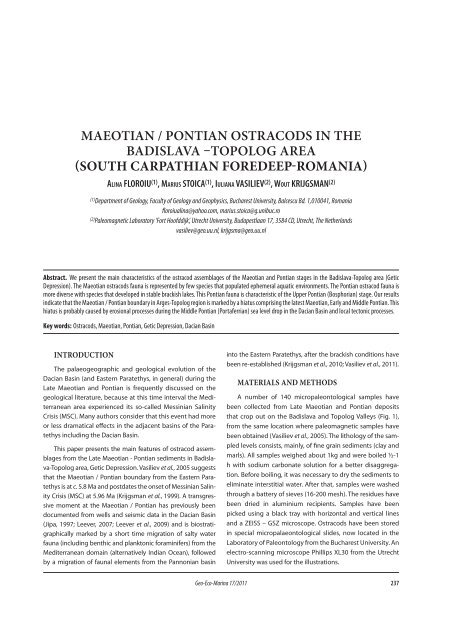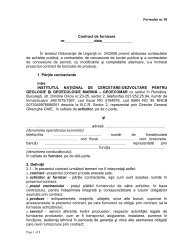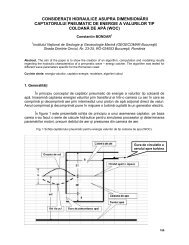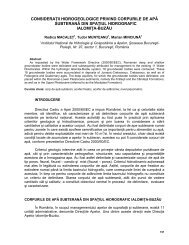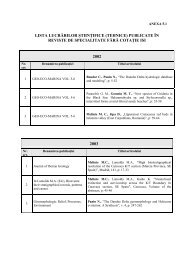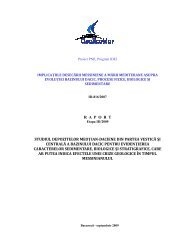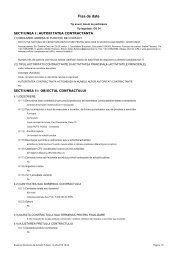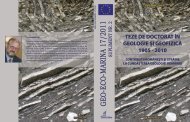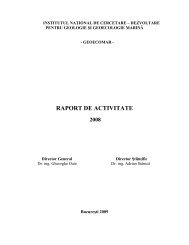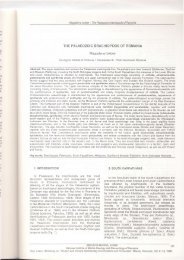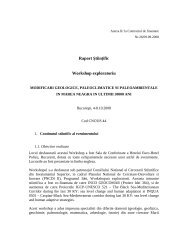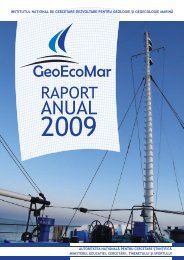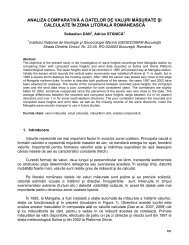Maeotian / Pontian ostracods in the Badislava ... - GeoEcoMar
Maeotian / Pontian ostracods in the Badislava ... - GeoEcoMar
Maeotian / Pontian ostracods in the Badislava ... - GeoEcoMar
You also want an ePaper? Increase the reach of your titles
YUMPU automatically turns print PDFs into web optimized ePapers that Google loves.
A. FLOROIU, M. STOICA, I. VASILIEV, W. KRIJGSMAN<br />
<strong>Maeotian</strong> / <strong>Pontian</strong> <strong>ostracods</strong> <strong>in</strong> <strong>the</strong><br />
<strong>Badislava</strong> –Topolog area<br />
(South carpathian foredeep-Romania)<br />
Al<strong>in</strong>a FLOROIU (1) , Marius STOICA (1) , Iuliana VASILIEV (2) , Wout KRIJGSMAN (2)<br />
(1) Department of Geology, Faculty of Geology and Geophysics, Bucharest University, Balcescu Bd. 1,010041, Romania<br />
floroiual<strong>in</strong>a@yahoo.com, marius.stoica@g.unibuc.ro<br />
(2) Paleomagnetic Laboratory ‘Fort Hoofddijk’, Utrecht University, Budapestlaan 17, 3584 CD, Utrecht, The Ne<strong>the</strong>rlands<br />
vasiliev@geo.uu.nl, krijgsma@geo.uu.nl<br />
Abstract. We present <strong>the</strong> ma<strong>in</strong> characteristics of <strong>the</strong> ostracod assemblages of <strong>the</strong> <strong>Maeotian</strong> and <strong>Pontian</strong> stages <strong>in</strong> <strong>the</strong> <strong>Badislava</strong>-Topolog area (Getic<br />
Depression). The <strong>Maeotian</strong> <strong>ostracods</strong> fauna is represented by few species that populated ephemeral aquatic environments. The <strong>Pontian</strong> ostracod fauna is<br />
more diverse with species that developed <strong>in</strong> stable brackish lakes. This <strong>Pontian</strong> fauna is characteristic of <strong>the</strong> Upper <strong>Pontian</strong> (Bosphorian) stage. Our results<br />
<strong>in</strong>dicate that <strong>the</strong> <strong>Maeotian</strong> / <strong>Pontian</strong> boundary <strong>in</strong> Arges-Topolog region is marked by a hiatus compris<strong>in</strong>g <strong>the</strong> latest <strong>Maeotian</strong>, Early and Middle <strong>Pontian</strong>. This<br />
hiatus is probably caused by erosional processes dur<strong>in</strong>g <strong>the</strong> Middle <strong>Pontian</strong> (Portaferrian) sea level drop <strong>in</strong> <strong>the</strong> Dacian Bas<strong>in</strong> and local tectonic processes.<br />
Key words: Ostracods, <strong>Maeotian</strong>, <strong>Pontian</strong>, Getic Depression, Dacian Bas<strong>in</strong><br />
Introduction<br />
The palaeogeographic and geological evolution of <strong>the</strong><br />
Dacian Bas<strong>in</strong> (and Eastern Paratethys, <strong>in</strong> general) dur<strong>in</strong>g <strong>the</strong><br />
Late <strong>Maeotian</strong> and <strong>Pontian</strong> is frequently discussed on <strong>the</strong><br />
geological literature, because at this time <strong>in</strong>terval <strong>the</strong> Mediterranean<br />
area experienced its so-called Mess<strong>in</strong>ian Sal<strong>in</strong>ity<br />
Crisis (MSC). Many authors consider that this event had more<br />
or less dramatical effects <strong>in</strong> <strong>the</strong> adjacent bas<strong>in</strong>s of <strong>the</strong> Paratethys<br />
<strong>in</strong>clud<strong>in</strong>g <strong>the</strong> Dacian Bas<strong>in</strong>.<br />
This paper presents <strong>the</strong> ma<strong>in</strong> features of ostracod assemblages<br />
from <strong>the</strong> Late <strong>Maeotian</strong> - <strong>Pontian</strong> sediments <strong>in</strong> <strong>Badislava</strong>-Topolog<br />
area, Getic Depression. Vasiliev et al., 2005 suggests<br />
that <strong>the</strong> <strong>Maeotian</strong> / <strong>Pontian</strong> boundary from <strong>the</strong> Eastern Paratethys<br />
is at c. 5.8 Ma and postdates <strong>the</strong> onset of Mess<strong>in</strong>ian Sal<strong>in</strong>ity<br />
Crisis (MSC) at 5.96 Ma (Krijgsman et al., 1999). A transgressive<br />
moment at <strong>the</strong> <strong>Maeotian</strong> / <strong>Pontian</strong> has previously been<br />
documented from wells and seismic data <strong>in</strong> <strong>the</strong> Dacian Bas<strong>in</strong><br />
(Jipa, 1997; Leever, 2007; Leever et al., 2009) and is biostratigraphically<br />
marked by a short time migration of salty water<br />
fauna (<strong>in</strong>clud<strong>in</strong>g benthic and planktonic foram<strong>in</strong>ifers) from <strong>the</strong><br />
Mediterranean doma<strong>in</strong> (alternatively Indian Ocean), followed<br />
by a migration of faunal elements from <strong>the</strong> Pannonian bas<strong>in</strong><br />
<strong>in</strong>to <strong>the</strong> Eastern Paratethys, after <strong>the</strong> brackish conditions have<br />
been re-established (Krijgsman et al., 2010; Vasiliev et al., 2011).<br />
Materials and methods<br />
A number of 140 micropaleontological samples have<br />
been collected from Late <strong>Maeotian</strong> and <strong>Pontian</strong> deposits<br />
that crop out on <strong>the</strong> <strong>Badislava</strong> and Topolog Valleys (Fig. 1),<br />
from <strong>the</strong> same location where paleomagnetic samples have<br />
been obta<strong>in</strong>ed (Vasiliev et al., 2005). The lithology of <strong>the</strong> sampled<br />
levels consists, ma<strong>in</strong>ly, of f<strong>in</strong>e gra<strong>in</strong> sediments (clay and<br />
marls). All samples weighed about 1kg and were boiled ½-1<br />
h with sodium carbonate solution for a better disaggregation.<br />
Before boil<strong>in</strong>g, it was necessary to dry <strong>the</strong> sediments to<br />
elim<strong>in</strong>ate <strong>in</strong>terstitial water. After that, samples were washed<br />
through a battery of sieves (16-200 mesh). The residues have<br />
been dried <strong>in</strong> alum<strong>in</strong>ium recipients. Samples have been<br />
picked us<strong>in</strong>g a black tray with horizontal and vertical l<strong>in</strong>es<br />
and a ZEISS – GSZ microscope. Ostracods have been stored<br />
<strong>in</strong> special micropalaeontological slides, now located <strong>in</strong> <strong>the</strong><br />
Laboratory of Paleontology from <strong>the</strong> Bucharest University. An<br />
electro-scann<strong>in</strong>g microscope Phillips XL30 from <strong>the</strong> Utrecht<br />
University was used for <strong>the</strong> illustrations.<br />
Geo-Eco-Mar<strong>in</strong>a 17/2011<br />
237
A. Floroiu, M. Stoica, I. Vasiliev, W. Krijgsman – <strong>Maeotian</strong> / <strong>Pontian</strong> <strong>ostracods</strong> <strong>in</strong> <strong>the</strong> <strong>Badislava</strong> –Topolog area<br />
Fig. 1. a) Simplified geotectonic map of Romanian Carpathians with <strong>the</strong> location of <strong>the</strong> study area; b) Geological map of <strong>the</strong> <strong>Badislava</strong> and<br />
Topolog Valleys area with <strong>the</strong> position of micropaleontological samples; c) North–South schematic cross section on <strong>the</strong> studied area; Figures a)<br />
and b) modified from Vasiliev et al., 2005<br />
Geological background<br />
The Getic Depression represents <strong>the</strong> sedimentary bas<strong>in</strong><br />
that developed at <strong>the</strong> contact between <strong>the</strong> South Carpathian<br />
nappe pile and <strong>the</strong> Moesian Platform (Sandulescu et al.,<br />
1984). The Late Miocene-Pliocene sedimentary successions<br />
from <strong>Badislava</strong> and Topolog Valleys regions are <strong>in</strong>tegrated<br />
<strong>in</strong>to a large monocl<strong>in</strong>al structure with 15 o -20 o plunge to <strong>the</strong><br />
SSE (Fig. 1). This structure is affected by N-S oriented faults<br />
that can generate up to 200 m of horizontal displacements.<br />
The Mio-Pliocene sedimentary successions are very well<br />
exposed <strong>in</strong> <strong>the</strong> nor<strong>the</strong>rn part of <strong>the</strong> Getic Depression, especially<br />
<strong>in</strong> <strong>the</strong> Topolog Valley. A magnetostratigraphic time<br />
scale has been developed for <strong>the</strong> <strong>Maeotian</strong>-Romanian deposits<br />
from this area (Vasiliev et al., 2005). The magnetic polarity<br />
pattern recorded <strong>in</strong> <strong>the</strong>se sections shows a succession of four<br />
relatively short normal and three reversed zones, followed by<br />
a long reversed <strong>in</strong>terval. The results were later <strong>in</strong>tegrated with<br />
biostratigraphical data based on mollusks (Stoica et al., 2007).<br />
The studied sections start <strong>in</strong> <strong>the</strong> Late <strong>Maeotian</strong> and end<br />
<strong>in</strong> <strong>the</strong> lower part of <strong>the</strong> Romanian, south of <strong>the</strong> confluence<br />
between <strong>the</strong> <strong>Badislava</strong> and Topolog Valleys (Fig. 1). The Upper<br />
<strong>Maeotian</strong> stage is here developed <strong>in</strong> a fluviatile-deltaic<br />
facies with frequently cont<strong>in</strong>ental type <strong>in</strong>tercalations. The<br />
sediments are represented by coarse gravels, oblique lam<strong>in</strong>ated<br />
sands, channel deposits <strong>in</strong>terbedded with “flood-pla<strong>in</strong>”<br />
deposits, fossil soils and lacustr<strong>in</strong>e clay (Figs 2, 4).<br />
The top of <strong>the</strong> <strong>Maeotian</strong> sequence is marked by an erosional<br />
surface. The overly<strong>in</strong>g <strong>Pontian</strong> deposits have a transgressive<br />
character. They are represented by a f<strong>in</strong><strong>in</strong>g-upward sequence<br />
that starts with coarse to medium-gra<strong>in</strong>ed pebbles and sands<br />
<strong>in</strong> <strong>the</strong> lower part, pass<strong>in</strong>g to predom<strong>in</strong>ant f<strong>in</strong>e-gra<strong>in</strong>ed deposits<br />
very rich <strong>in</strong> mollusks and <strong>ostracods</strong> <strong>in</strong> <strong>the</strong> upper part (Figs 3,<br />
4). This discont<strong>in</strong>uity <strong>in</strong> <strong>the</strong> marg<strong>in</strong>al areas of central part of <strong>the</strong><br />
Carpathian Foredeep can also be noticed on <strong>the</strong> <strong>in</strong>terpretations<br />
of seismic l<strong>in</strong>es from <strong>the</strong> westernmost part of <strong>the</strong> Dacian<br />
Bas<strong>in</strong> (Leever, 2007, Leever et al., 2009).<br />
Results and discussion<br />
Based on detailed mapp<strong>in</strong>g and sampl<strong>in</strong>g of <strong>the</strong> <strong>Maeotian</strong><br />
and <strong>Pontian</strong> sequences from <strong>the</strong> <strong>in</strong>vestigated area we<br />
present here <strong>the</strong> ma<strong>in</strong> characteristics of <strong>the</strong> ostracod assemblages<br />
from this time <strong>in</strong>terval and a reconstruction of <strong>the</strong> palaeoenvironments.<br />
The Upper <strong>Maeotian</strong> deposits from <strong>the</strong> <strong>Badislava</strong> and<br />
Toplog sections reach up to 250 m <strong>in</strong> thickness. Sediments<br />
are represented by coarse gravels, oblique lam<strong>in</strong>ated sands,<br />
channel and “flood-pla<strong>in</strong>” type deposits, fossil soils and lacustr<strong>in</strong>e<br />
clays (Figs. 2, 4). The f<strong>in</strong>e-gra<strong>in</strong>ed <strong>in</strong>tercalations are<br />
238 Geo-Eco-Mar<strong>in</strong>a 17/2011
A. Floroiu, M. Stoica, I. Vasiliev, W. Krijgsman – <strong>Maeotian</strong> / <strong>Pontian</strong> <strong>ostracods</strong> <strong>in</strong> <strong>the</strong> <strong>Badislava</strong> –Topolog area<br />
Fig. 2. Litho-facial aspects of <strong>Maeotian</strong> deposits from <strong>Badislava</strong> Valley section; a) Fluvial deposits with sands and gravel lenses; b) Small channel<br />
cut on flood pla<strong>in</strong> deposits; on <strong>the</strong> edge of <strong>the</strong> channel, can be observed fossil roots <strong>in</strong> orig<strong>in</strong>al position; c) Interbedded blackish fossil soils and<br />
flood-pla<strong>in</strong> silts; d) Erosional contact between Upper <strong>Maeotian</strong> flood-pla<strong>in</strong> deposits and Upper <strong>Pontian</strong> littoral sands and f<strong>in</strong>e gravels<br />
represented by gray or brownish clays and silts with frequent<br />
calcareous concretions, as well as blackish layers rich <strong>in</strong> plant<br />
debris. They are very scarce <strong>in</strong> fossil rema<strong>in</strong>s, only few bad preserved<br />
shells of cont<strong>in</strong>ental or freshwater gastropods (species<br />
of Helicidae and Planorbidae) and bivalves (species of Unionidae)<br />
have been observed (Stoica et al., 2007). The microfauna<br />
is represented by few species of fresh water <strong>ostracods</strong>:<br />
Candoniella sp.; Candona sp.; Paracandona albicans (Brady);<br />
Ilyocypris bradyi Sars (Fig 4, Plate 1). These species populated<br />
unstable environments, such as lakes, rivers with temporary<br />
existence and flood-pla<strong>in</strong>s. Paracandona albicans, (<strong>the</strong> adult<br />
specimens show reticulate valves easy to be confused with<br />
juveniles of Pseudocandona Kaufman), lives <strong>in</strong> fresh-water rivers,<br />
lakes and pools. In <strong>the</strong> Dacian Bas<strong>in</strong>, it has been described<br />
<strong>in</strong> <strong>the</strong> <strong>Maeotian</strong>, Dacian and Romanian fresh water sediments<br />
associated with Cyprideis heterostigma sublittoralis and Cyclocypris<br />
sp (Olteanu <strong>in</strong> Papaianopol et al., 1987; Olteanu, 1995).<br />
This scarce <strong>Maeotian</strong> ostracod fauna from <strong>in</strong>vestigated area<br />
differs essentially from <strong>the</strong> diversified one of <strong>the</strong> same stage<br />
from zones that evolved <strong>in</strong> bas<strong>in</strong>al conditions.<br />
Above <strong>the</strong> erosional surface, <strong>the</strong> <strong>Pontian</strong> starts with sands<br />
and silts, that frequent present wave ripples structures, which<br />
pass to more f<strong>in</strong>e-gra<strong>in</strong>ed deposits <strong>in</strong> <strong>the</strong> upper part. The f<strong>in</strong>egra<strong>in</strong>ed<br />
sediments provided a rich ostracod fauna, <strong>in</strong>dicative<br />
of <strong>the</strong> Upper <strong>Pontian</strong> (Bosphorian): Amplocypris dorsobrevis<br />
Sokac; Scottia sp.; Cypria tocorjescui Hanganu; Candona (Caspiocypris)<br />
ex. gr. alta (Zal.); Candona (Caspiolla) osso<strong>in</strong>ae Krst.;<br />
Candona (Caspiolla) venusta (Zal.); Candona (Pontoniella) acum<strong>in</strong>ata<br />
striata Mandelstam; Candona (Pontoniella) excellentis<br />
Olteanu; Candona (Pontoniella) sp.; Candona neglecta Sars;<br />
Bakunella dorsoarcuata (Zal.); Bakunella sp.; Cyprideis sp.1;<br />
Cyprideis sp. 2; Tyrrhenocy<strong>the</strong>re filipescui (Hanganu); Tyrrhenocy<strong>the</strong>re<br />
motasi Olteanu; Tyrrhenocy<strong>the</strong>re sp.1; Tyrrhenocy<strong>the</strong>re<br />
sp.2; Leptocy<strong>the</strong>re (Amnicy<strong>the</strong>re) palimpsesta Liv.; Leptocy<strong>the</strong>re<br />
Geo-Eco-Mar<strong>in</strong>a 17/2011<br />
239
A. Floroiu, M. Stoica, I. Vasiliev, W. Krijgsman – <strong>Maeotian</strong> / <strong>Pontian</strong> <strong>ostracods</strong> <strong>in</strong> <strong>the</strong> <strong>Badislava</strong> –Topolog area<br />
picturata Liv.; Leptocy<strong>the</strong>re (Amnicy<strong>the</strong>re) multituberculata<br />
(Liv.); Leptocy<strong>the</strong>re sp.; Leptocy<strong>the</strong>re () ex. gr. bosqueti (Liv.);<br />
Loxoconcha babazananica Liv.; Loxoconcha schweyeri Suz<strong>in</strong>;<br />
Loxoconcha petasa Liv.; Loxoconcha sp. (Fig. 4, Plate 1).<br />
The Bosphorian <strong>ostracods</strong> are more abundant and are<br />
represented by typical species of this sub-stage, as well as by<br />
species that cont<strong>in</strong>ue to exist <strong>in</strong> <strong>the</strong> Lower Dacian (Getian). In<br />
<strong>the</strong> Dacian Bas<strong>in</strong>, Cypria tocorjescui was described for <strong>the</strong> first<br />
time (Hanganu, 1962) from so-called Paradacna abichi levels<br />
(Lower <strong>Pontian</strong>) and, apparently, it migrated from <strong>the</strong> Pannonian<br />
Bas<strong>in</strong> (Pipick <strong>in</strong> Cziczer et al. 2009). This species was also<br />
noticed <strong>in</strong> <strong>the</strong> Upper <strong>Pontian</strong> sediments with Phyllocardium<br />
planum planum bivalve shells (Hanganu, 1974).<br />
In our samples, we observed <strong>the</strong> high abundance of<br />
Tyrrhenocy<strong>the</strong>re species. Most of <strong>the</strong>m appeared <strong>in</strong> <strong>the</strong> Dacian<br />
Bas<strong>in</strong> dur<strong>in</strong>g <strong>the</strong> Middle <strong>Pontian</strong> (Portaferrian) and are<br />
well represented <strong>in</strong> <strong>the</strong> Upper <strong>Pontian</strong> (Boshporian), too. The<br />
“bloom” of Tyrrhenocy<strong>the</strong>re filipescui Hanganu <strong>in</strong> Bosphorian<br />
is accompanied by <strong>the</strong> presence of Scottia sp. (Hanganu,<br />
1985). T. filipescui is <strong>the</strong> most conservative species of <strong>the</strong> genus<br />
hav<strong>in</strong>g <strong>the</strong> most extended distribution <strong>in</strong> time, from <strong>the</strong><br />
base of Middle <strong>Pontian</strong> up to <strong>the</strong> Lower Dacian (Olteanu and<br />
Vekua, 1989).<br />
The first apparition of Bakunella genus is recorded, start<strong>in</strong>g<br />
with <strong>the</strong> second part of <strong>the</strong> Lower <strong>Pontian</strong>. Dur<strong>in</strong>g <strong>the</strong> <strong>Pontian</strong>,<br />
this genus is represented by one species: Bakunella dorsoarcuata<br />
(Zal.). This species seems to be ra<strong>the</strong>r conservative concern<strong>in</strong>g<br />
<strong>the</strong> ornamentation pattern along <strong>the</strong> <strong>Pontian</strong>, some<br />
changes appear<strong>in</strong>g only dur<strong>in</strong>g <strong>the</strong> Dacian (Olteanu, 1989). B.<br />
dorsoarcuata probably evolved <strong>in</strong> Lake Pannon and was endemic<br />
to that lake until <strong>the</strong> Latest Miocene (Pipick <strong>in</strong> Cziczer et<br />
al. 2009). This species is liv<strong>in</strong>g today <strong>in</strong> sublittoral to profundal<br />
depths, <strong>in</strong> <strong>the</strong> central and sou<strong>the</strong>rn Caspian Bas<strong>in</strong>, at sal<strong>in</strong>ities<br />
of 11.5–13.5% (Gofman 1966, Boomer et al. 2005). Gliozzi,<br />
2007, mentioned <strong>the</strong> presence of B. dorsoarcuata <strong>in</strong> <strong>the</strong> Late<br />
Tortonian - Early Mess<strong>in</strong>ian deposits from Mediterranean area<br />
toge<strong>the</strong>r with o<strong>the</strong>r <strong>ostracods</strong> that migrated from Paratethys<br />
before <strong>the</strong> onset of MSC. Pontoniella genus emerged with <strong>the</strong><br />
Lower <strong>Pontian</strong>, followed immediately by Bakunella.<br />
Fig. 3. Litho-facial aspects of Upper <strong>Pontian</strong> deposits from <strong>Badislava</strong> Valley section a) Sandy littoral deposits with pelitic <strong>in</strong>tercalations transgressively<br />
overlay<strong>in</strong>g <strong>the</strong> Meotian deposits (basal part of Upper <strong>Pontian</strong>, left bank of <strong>Badislava</strong> Valley); b) Symmetrical wave ripples on Upper <strong>Pontian</strong><br />
sandy deposits; c) Upper <strong>Pontian</strong> <strong>in</strong>terbedded marls and silts nicely exposed on <strong>the</strong> <strong>Badislava</strong> River; d) Silty layer very rich <strong>in</strong> mollusk shells<br />
(Limnocardiidae bivalves and Vivipariidae gastropods)<br />
240 Geo-Eco-Mar<strong>in</strong>a 17/2011
A. Floroiu, M. Stoica, I. Vasiliev, W. Krijgsman – <strong>Maeotian</strong> / <strong>Pontian</strong> <strong>ostracods</strong> <strong>in</strong> <strong>the</strong> <strong>Badislava</strong> –Topolog area<br />
Fig. 4. Syn<strong>the</strong>thic log, ma<strong>in</strong> litho-logical characteristics and ostracod assemblages of Upper <strong>Maeotian</strong>, Upper <strong>Pontian</strong> deposits from<br />
<strong>Badislava</strong> Valley section<br />
Geo-Eco-Mar<strong>in</strong>a 17/2011<br />
241
A. Floroiu, M. Stoica, I. Vasiliev, W. Krijgsman – <strong>Maeotian</strong> / <strong>Pontian</strong> <strong>ostracods</strong> <strong>in</strong> <strong>the</strong> <strong>Badislava</strong> –Topolog area<br />
PLATE 1 <strong>Maeotian</strong> and <strong>Pontian</strong> <strong>ostracods</strong> from <strong>Badislava</strong> Valley section (all specimens represent adult valves, external lateral views,<br />
LV=left valve, RV=right valve, BBM 09-micropaleontological sample). 1. Candoniella sp., LV, <strong>Maeotian</strong>, (BBM 09); 2. Paracandona albicans (Brady), LV,<br />
<strong>Maeotian</strong>, (BBM 11); 3. Iliocypris bradyi Sars, RV, <strong>Maeotian</strong>, (BBM 09); 4. Amplocypris dorsobrevis Sokac, RV, Upper <strong>Pontian</strong>, (BBM 41); 5. Cypria tocorjescui<br />
Hanganu, RV, Upper <strong>Pontian</strong>, (BBM 47); 6. Scottia sp., RV, Upper <strong>Pontian</strong>, (BBM 39); 7. Candona (Caspiocypris) ex. gr. alta (Zal.), LV, Upper <strong>Pontian</strong>,<br />
(BBM 43); 8. Candona (Caspiolla) osso<strong>in</strong>ae Krst., LV, Upper <strong>Pontian</strong>, (BBM 39); 9. Candona (Caspiolla) venusta (Zal.), LV, Upper <strong>Pontian</strong>, (BBM 40);<br />
10. Candona (Pontoniella) acum<strong>in</strong>ata striata Mandelstam, RV, Upper <strong>Pontian</strong>, (BBM 28); 11. Candona (Pontoniella) sp., RV, Upper <strong>Pontian</strong>, (BBM 40);<br />
12. Candona (Pontoniella) excellentis Olteanu, LV, Upper <strong>Pontian</strong>, (BBM 28); 13. Candona neglecta Sars, RV, Upper <strong>Pontian</strong>, (BBM 50); 14. Bakunella<br />
dorsoarcuata (Zal.), RV, Upper <strong>Pontian</strong>, (BBM 52); 15. Cyprideis sp. 1, RV, Upper <strong>Pontian</strong>, (BBM 40); 16. Cyprideis sp. 2, RV, Upper <strong>Pontian</strong>, (BBM 41);<br />
17. Tyrrhenocy<strong>the</strong>re filipescui (Hanganu), LV, Upper <strong>Pontian</strong>, (BBM 33); 18. Tyrrhenocy<strong>the</strong>re motasi Olteanu, LV, Upper <strong>Pontian</strong>, (BBM 33); 19. Leptocy<strong>the</strong>re<br />
(Amnicy<strong>the</strong>re) palimpsesta Liv., RV, Upper <strong>Pontian</strong>, (BBM 47); 20. Leptocy<strong>the</strong>re () ex. gr. bosqueti (Liv.), LV, Upper <strong>Pontian</strong>, (BBM 38);<br />
21. Loxoconcha schweyeri Suz<strong>in</strong>, RV, Upper <strong>Pontian</strong>, (BBM 52); 22. Loxoconcha babazananica Liv., RV, Upper <strong>Pontian</strong>, (BBM 48)<br />
242 Geo-Eco-Mar<strong>in</strong>a 17/2011
A. Floroiu, M. Stoica, I. Vasiliev, W. Krijgsman – <strong>Maeotian</strong> / <strong>Pontian</strong> <strong>ostracods</strong> <strong>in</strong> <strong>the</strong> <strong>Badislava</strong> –Topolog area<br />
An important characteristic of ostracod assemblage<br />
from <strong>the</strong> <strong>in</strong>vestigated area is represented by <strong>the</strong> high development<br />
of Amplocypris genus, <strong>in</strong> <strong>the</strong> second part of Upper<br />
<strong>Pontian</strong>. This genus, with a large shell is represented by<br />
Amplocypris dorsobrevis Sokač, and has been found <strong>in</strong> several<br />
localities with <strong>Pontian</strong> sediments from Dacian Bas<strong>in</strong>, as well<br />
as <strong>in</strong> Yugoslavia (Hanganu, 1976, Sokač, 1989). A similar species<br />
is described by (Olteanu, 1995) from <strong>the</strong> Lower Dacian<br />
sediments (Mare Valley-Bengesti) as A. odessaensis (Ilnitzkaia).<br />
However, some additional morphometric studies are needed<br />
to f<strong>in</strong>d out which are <strong>the</strong> real Amplocypris species <strong>in</strong> <strong>the</strong><br />
Dacian Bas<strong>in</strong>. The Cyprideis genus is represented by several<br />
different morphotypes, but, for <strong>the</strong> moment, it is difficult to<br />
mention <strong>the</strong>ir specific affiliation.<br />
The Upper <strong>Pontian</strong> (Bosphorian) deposits from <strong>the</strong> study<br />
area conta<strong>in</strong> also very rich mollusk assemblages dom<strong>in</strong>ated<br />
by brackish bivalves and gastropods (Stoica et al., 2007).<br />
Conclusions<br />
The <strong>Maeotian</strong> / <strong>Pontian</strong> transition on <strong>Badislava</strong> Valley section<br />
comprises an erosional event, with Upper <strong>Pontian</strong> sediments<br />
discordantly overly<strong>in</strong>g <strong>the</strong> <strong>Maeotian</strong> deposits, possibly,<br />
as a consequence of <strong>the</strong> Middle <strong>Pontian</strong> sea level drop<br />
<strong>in</strong> <strong>the</strong> Dacian Bas<strong>in</strong> or local tectonic processes. There are no<br />
<strong>in</strong>dications for <strong>the</strong> presence of <strong>the</strong> Lower and Middle <strong>Pontian</strong><br />
(Odessian and Portaferrian) substages.<br />
This onset of <strong>the</strong> Upper <strong>Pontian</strong> littoral sediments followed<br />
by shallow bas<strong>in</strong>al ones directly on <strong>the</strong> <strong>Maeotian</strong><br />
fluvial deposits is related to a transgressive moment <strong>in</strong> <strong>the</strong><br />
Dacian Bas<strong>in</strong>. This is <strong>the</strong> last important high stand period<br />
<strong>in</strong> <strong>the</strong> Dacian Bas<strong>in</strong> and can possibly be correlated with <strong>the</strong><br />
Zanclean transgression (5.33 Ma) of <strong>the</strong> Mediterranean Bas<strong>in</strong>.<br />
This event marks <strong>the</strong> Miocene / Pliocene boundary and illustrates<br />
<strong>the</strong> complex <strong>in</strong>teractions between <strong>the</strong> Mediterranean<br />
and Oriental Paratethys Bas<strong>in</strong>s (<strong>in</strong>clud<strong>in</strong>g <strong>the</strong> Dacian Bas<strong>in</strong>) <strong>in</strong><br />
Late Miocene – Early Pliocene times.<br />
The <strong>Maeotian</strong> ostracod fauna is pore developed and is<br />
represented by few fresh water species able to populate<br />
ephemeral aquatic environments. By contrast, <strong>the</strong> Upper<br />
<strong>Pontian</strong> one is more diverse and conta<strong>in</strong>s numerous species<br />
characteristic for brackish and more stable shallow water environment.<br />
References<br />
Boomer I., von Grafenste<strong>in</strong> U., Guichard F., Bieda S., 2005. Modern and<br />
Holocene sublittoral ostracod assemblages (Crustacea) from <strong>the</strong><br />
Caspian Sea: A unique brackish, deep-water environment. Palaeogeography,<br />
Palaeoclimatology, Palaeoecology, 225: 173–186.<br />
Cziczer I., Magyar I., Pipík R., Böhme M., Ćorić S., Bakrač K., Sütő-Szentai M.,<br />
Lantos M., Bab<strong>in</strong>szki E., Müller P., 2009. Life <strong>in</strong> <strong>the</strong> sublittoral zone<br />
of long-lived Lake Pannon: paleontological analysis of <strong>the</strong> Upper<br />
Miocene Szák Formation, Hungary. Int. J. Earth Sci (Geol Rundsch),<br />
98: 1741 -1766.<br />
Gliozzi E., Ceci M.E., Grossi F., & Ligios S., 2007. Paratethyan Ostracod immigrants<br />
<strong>in</strong> Italy dur<strong>in</strong>g <strong>the</strong> Late Miocene. Geobios, 40 (3): 325-337.<br />
Gofman E.A., 1966. Ekologia sovremennykh i novokaspiiskikh ostrakod<br />
Kaspiiskogo moria (Ecology of <strong>the</strong> liv<strong>in</strong>g and new Caspian<br />
ostracodes of <strong>the</strong> Caspian Sea). Nauka, Moscow, pp. 1-183.<br />
Hanganu E., 1974. Observation sur l‘ostracofaune pontienne de la région<br />
comprise a la vallée du Danube et la vallée du Motru. Revista<br />
Española de Micropaleontologia VI(3): 335-345.<br />
Hanganu E., 1976. Nouvelles especes de Cyprididae dans le Dacien<br />
superieur de la Muntenie orientale (Roumanie). Bull. Soc. Belge.<br />
Géol. 85(2): 51-61.<br />
Hanganu E., 1985. Un nouveau composant de la faune d‘ostracodes<br />
néogènes post-Méotiens du Bass<strong>in</strong> Dacique (Roumanie). Rév.<br />
Roum. Géol. Géophys. Géogr., Géol. 29: 65-71.<br />
Jipa D., 1997. Late Neogene–Quaternary evolution of Dacian bas<strong>in</strong><br />
(Romanian). Ananalysis of sediment thickness pattern. Geo-Eco-<br />
Mar<strong>in</strong>a 2, 127–134.<br />
Krijgsman W., Hilgen F.J., Raffi I., Sierro F.J., Wilson D., 1999. Chronology,<br />
causes and progression of <strong>the</strong> Mess<strong>in</strong>ian Sal<strong>in</strong>ity Crisis. Nature,<br />
400, p. 652-655.<br />
Krijgsman W., Stoica M., Vasiliev I., Popov V.V., 2010. Rise and fall of <strong>the</strong><br />
Paratethys Sea dur<strong>in</strong>g <strong>the</strong> Mess<strong>in</strong>ian Sal<strong>in</strong>ity Crisis. Earth and Planetary<br />
Science Letters, 290, p. 183-191.<br />
Leever K., 2007. Foreland of <strong>the</strong> Romanian Carpathians – controls on<br />
late orogenic sedimentary bas<strong>in</strong> evolution and Paratethys paleogeography.<br />
PhD <strong>the</strong>sis, Vrije Universiteit Amsterdam.<br />
Leever K.A., Matenco L., Răbăgia T.,Cloet<strong>in</strong>gh S., Krijgsman W., Stoica M.,<br />
2009. Mess<strong>in</strong>ian sea level fall <strong>in</strong> <strong>the</strong> Dacic Bas<strong>in</strong> (Eastern Paratethys):<br />
palaeogeographical implications from seismic sequence<br />
stratigraphy. Terra Nova, 22, 12-17.<br />
Olteanu R., 1989. New Ostracodes <strong>in</strong> Upper Neogene from Romania.<br />
Mem. Inst. Geol. Geofiz. 34: 123-182.<br />
Olteanu R., 1995. Dacian ostracodes. Chronostratigraphie und Neostratotypen.<br />
F. Mar<strong>in</strong>escu and I. Papaianopol eds. Bucuresti, Ed.<br />
Acad. Romane. IX, Pliozän, Dazian: 268-323.<br />
Olteanu R., Vekua M., 1989. Quelques considérations sur les genres<br />
Tyrrhenocy<strong>the</strong>re (Ruggieri, 1995) et Hemicy<strong>the</strong>ria (Pokornyi, 1955)<br />
(Ostracoda, Crustacea) du Négène Supérieur de la Paratéthys.<br />
Geobios, 22 (1), p. 65-79, 9 fig., 3 pl.<br />
Papaianopol I., Grigoraş M., Popescu A., Olteanu R., Rogge E., Iva M., Costea<br />
C., Pîslaru T., Munteanu E., 1987. L‘étude du Néogène Supérieur de<br />
la partie orientale de la Plate-Forme Moesienne (secteur d‘entre<br />
la Vallée de Neajlov et le Danube) à considérations sur le Complexe<br />
Houiller. D. S. Inst. Geol. Geofiz. 72-73(4): p. 209-260.<br />
Geo-Eco-Mar<strong>in</strong>a 17/2011<br />
243
A. Floroiu, M. Stoica, I. Vasiliev, W. Krijgsman – <strong>Maeotian</strong> / <strong>Pontian</strong> <strong>ostracods</strong> <strong>in</strong> <strong>the</strong> <strong>Badislava</strong> –Topolog area<br />
Sandulescu M., 1984. Geotectonica Romaniei, 450, pp., Editura Tehnica,<br />
Bucuresti.<br />
Sokac A., 1989. <strong>Pontian</strong> Ostracod fauna <strong>in</strong> <strong>the</strong> Pannonian Bas<strong>in</strong>.<br />
Chronostratigraphie und Neostratotypen: Neogen der Westlichen<br />
(“Zentrale”) Paratethys 8. Pontien . P. Stevanovic, L. A. Nevesskaya,<br />
F. Mar<strong>in</strong>escu et al eds, Jazu and Sanu, Zagreb-Beograd:<br />
672–721.<br />
Stoica M., Lazar I., Vasiliev I., Krijgsman W., 2007. Mollusc assemblages of <strong>the</strong><br />
<strong>Pontian</strong> and Dacian deposits from <strong>the</strong> Topolog – Arges area (sou<strong>the</strong>rn<br />
Carpathian foredeep – Romania). Geobios, 40, p. 391-405.<br />
Vasiliev I., Krijgsman W., Stoica M., Langereis C.G., 2005. Mio-Pliocene<br />
magnetostratigraphy <strong>in</strong> <strong>the</strong> sou<strong>the</strong>rn Carpathian foredeep and<br />
Mediterranean-Paratethys correlations. Terra Nova, 17, p. 376-<br />
384.<br />
Vasiliev I., Iosifidi A.G., Vasiliev I., Khramov A.N., Krijgsman W., Kuiper K., Langereis<br />
C.G., Popov V.V., Stoica M., Tomsha V.A., Yud<strong>in</strong> S.V., 2011. Magnetostratigraphy<br />
and radio-isotope dat<strong>in</strong>g of upper Miocene–<br />
lower Pliocene sedimentary successions of <strong>the</strong> Black Sea Bas<strong>in</strong><br />
(Taman Pen<strong>in</strong>sula, Russia). Palaeogeography, Palaeoclimatology,<br />
Palaeoecology, 310 (3-4): 163-175.<br />
244 Geo-Eco-Mar<strong>in</strong>a 17/2011


